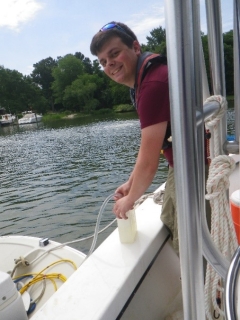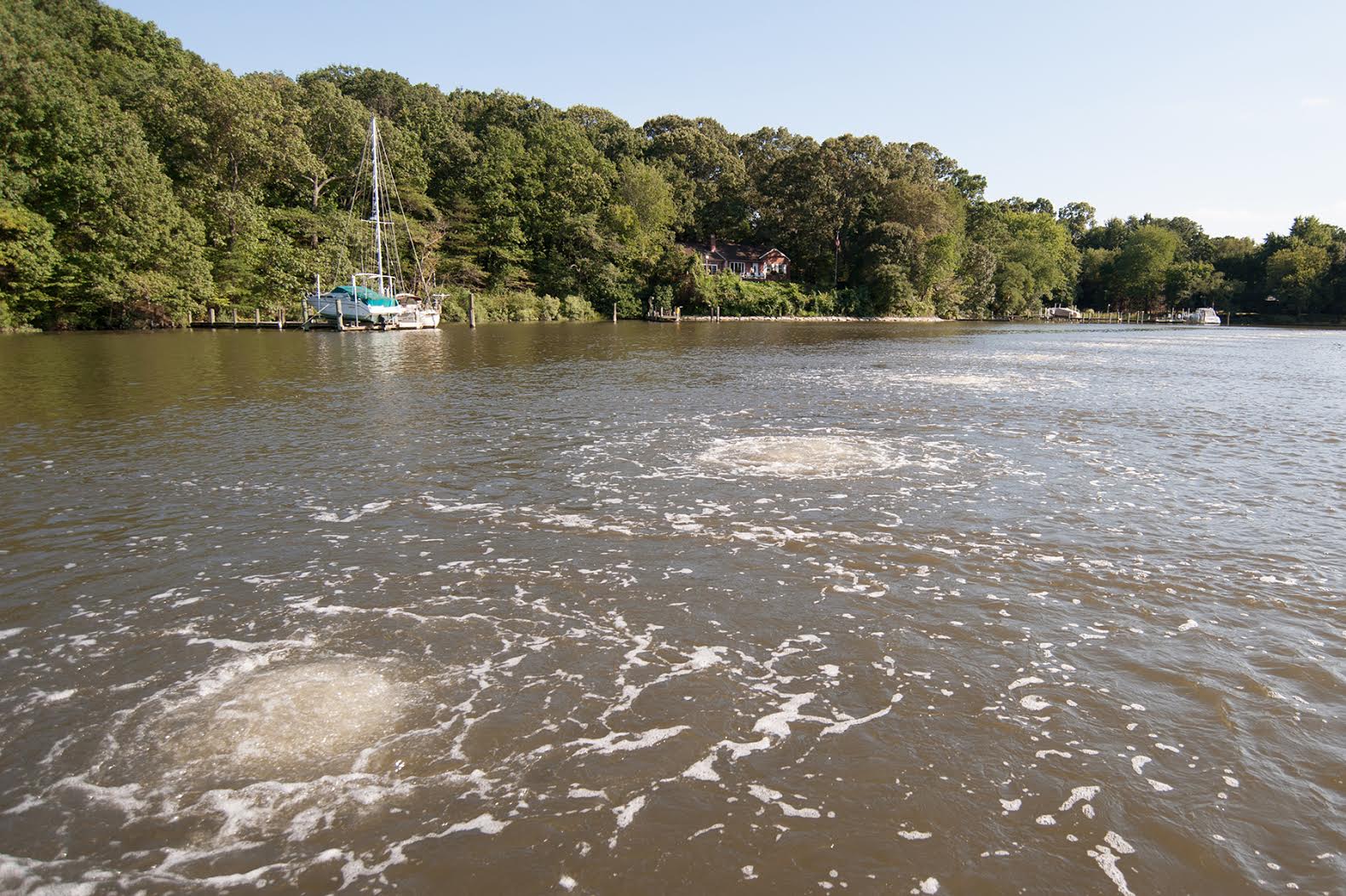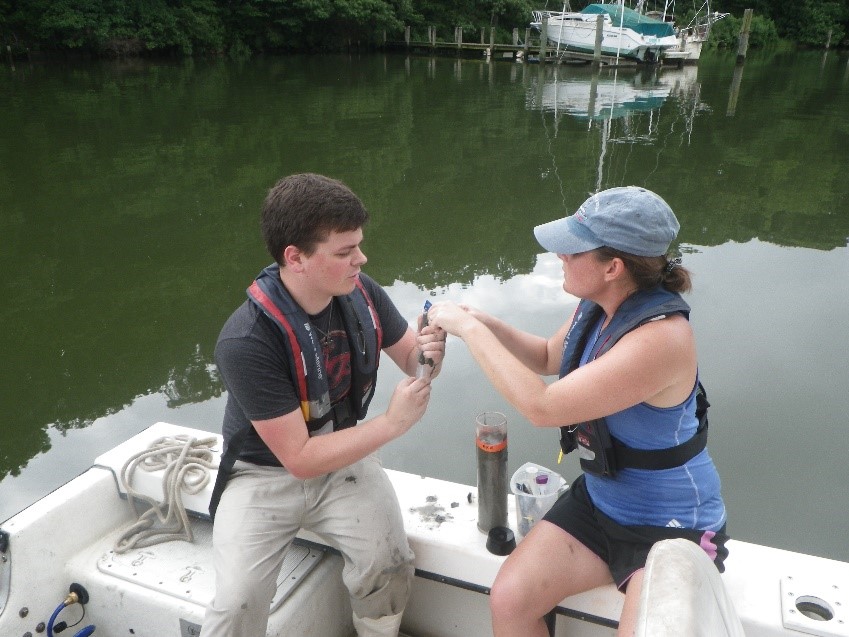Knauss legislative fellowships in Congress help build careers — and they're fun and educational. See our video and fact sheet for details.
Bubble, Bubble: A Community's Fix for Bad Smells Offers a Unique Research Opportunity
On a small tributary of the Patapsco River in Pasadena, Maryland, an avid community of fishermen and boaters frequent the waters daily during the spring and summer. This river, Rock Creek, is home to the Maryland Yacht club and sees a high volume of boat traffic. Due to its recreational and economic relevance, this waterway is central to the community of Pasadena. Although it appears to be an otherwise typical Chesapeake Bay community, Rock Creek is home to a fascinating story where science, natural resource management, and the local community come together. My thesis project takes place at that crossroads.
Approximately 80 percent of the Rock Creek watershed is residential area, and about half the homes in this area use septic systems for waste removal. Some of the tidal waters entering Rock Creek flow there via the Patapsco River from Baltimore, a city with a history of high water pollution. Water entering from the Patapsco River tends to stagnate, as water can sit in Rock Creek for a relatively long time (about 13 to 32 days) before being flushed out. Unfortunately, these features of the tributary lead to poor water quality. In the 1980s, community residents saw massive fish kills and became annoyed by the frequent smell of rotting eggs. Some residents claim that the concentration of hydrogen sulfide in air near the creek was so high that paint had begun to peel off houses.
|
|
|
The aerators of Rock Creek, Pasadena, Maryland, create a swirl of bubbles at the surface. When fully operational, the aerators pump over 15,000 liters of air per minute into the water. Photo credit: Nicole Lehming |
The reason for these unpleasant conditions: Rock Creek’s water had too little oxygen and too much nutrients. An increase in nutrient pollution fueled blooms of phytoplankton (algae). This increase in organic matter (in this case, in the form of phytoplankton) is known as eutrophication, and Rock Creek had become eutrophic. Eutrophication typically results in a multitude of water quality problems. As the phytoplankton die, decomposition of their cells depletes oxygen in the water column. When bacteria in the water no longer have access to oxygen, they resort to “breathing” sulfate to survive, a process that gives off hydrogen sulfide as a by-product, which creates the smell of sulfur or rotting eggs. Water clarity decreases as the phytoplankton overpopulate the water. Understandably, the residents were not happy.
To help remedy these problems, Anne Arundel County installed in 1988 an aeration system in an 800-meter stretch of the estuary. The system is designed to pump atmospheric air into the water to mix the water column and add oxygen, much like a bubbler in a backyard pond. The bubbler is operating daily now that summer has arrived.
This unusual pairing of artificial oxygen supplementation and eutrophic conditions attracted the attention of estuary ecologists. Nearly 30 years later, the system is still operational, and scientists (and grad students!) are still studying Rock Creek.
While the aeration system was originally intended to help water quality (and is still operational today for this reason), the system provides a unique opportunity for comparative experimentation. Having this level of control of oxygen concentrations at the ecosystem scale is rare; comparative experimentation controlling for chemical concentrations in the water is normally reserved for lab experiments, not whole-ecosystem experiments. By turning the aeration system on and off and taking measurements, we can discern what effects oxygen has on a eutrophic system. Specifically, we are looking at water quality parameters, and rates of photosynthesis and oxygen consumption, and how various elements and chemicals change forms within Rock Creek.
|
|
| Casey Hodgkins (right) of the Chesapeake Biological Lab and I processing sediment samples. Sediments can provide insight into the biogeochemical cycles of Rock Creek. Photo credit: Melissa Day |
Naturally, the Rock Creek community is highly invested in the health of their estuary. The residents would prefer clean, swimmable water brimming with fish. However, cleaning a waterway downstream of Baltimore is no easy task. The lab groups of Drs. Lora Harris and Jeremy Testa of the Chesapeake Biological Laboratory of the University of Maryland Center for Environmental Science are working with a group known as Restore Rock Creek to establish long-term goals for the health of Rock Creek. Educating the community on the complexities of the situation is important, as they seek impactful ways to restore the system in ways that make sense. We must also establish what is practical, as restoring the estuary entirely will be a lengthy endeavor. We are hoping to turn the local interest into a citizen’s science initiative in which volunteers collect long-term data about Rock Creek.
Learning about the science of the ecosystem, the decisions behind the management, and the community response to the work in Rock Creek has provided me a unique experience. Our results will have implications for management and restoration of Rock Creek and other waterways like it. The factors at work to reinforce the eutrophic state of Rock Creek are both unfortunate and fascinating. I have never conducted research where the implications were of such high interest to the public, and I have never worked with management officials so closely to coordinate a project. Now that most of my data have been collected, I am excited to see what conclusions I can draw from this special system.
Photo, top left: Zach Gotthardt sampling in Rock Creek, Pasadena, Maryland. Credit: Melissa Day
See all posts to the Fellowship Experiences blog




